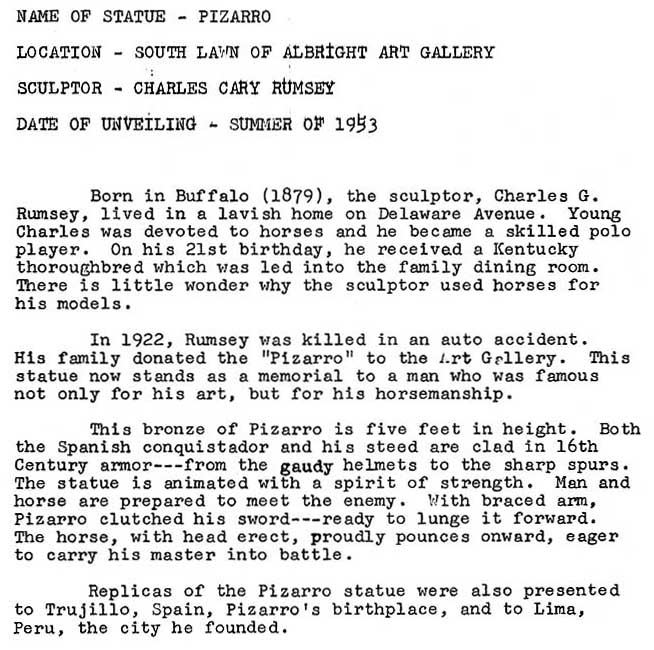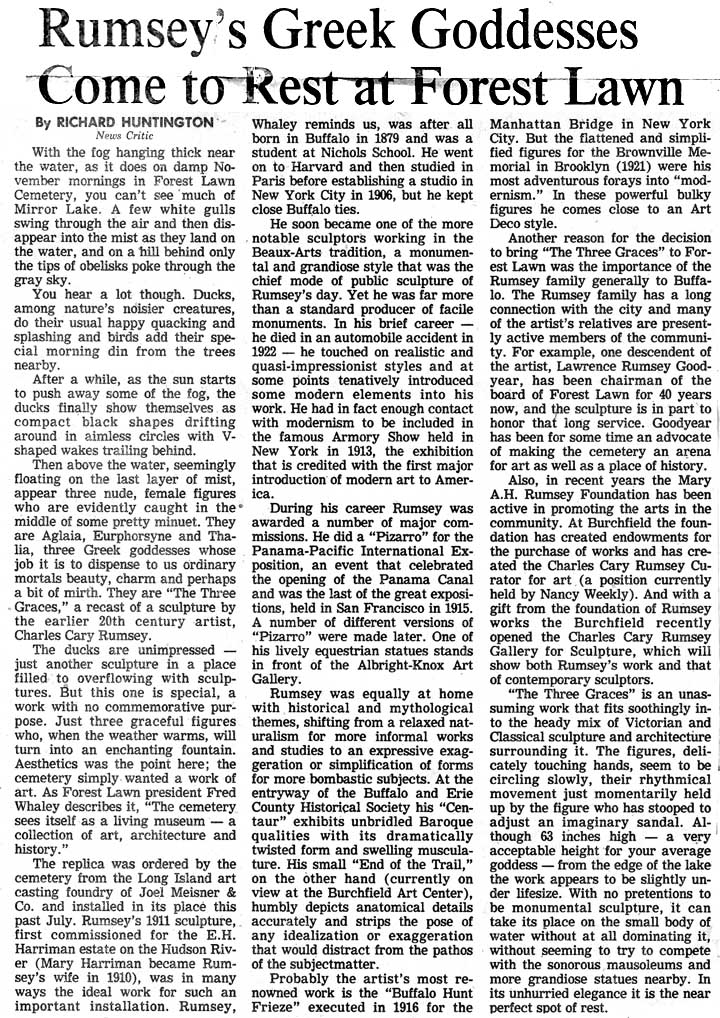Charles Cary Rumsey ..........................
Albright-Knox - Table of Contents
..........................
Public Art - Table of
Contents
Pizarro - Albright-Knox Art Gallery
By Charles Cary RumseyAlbright-Knox Art Gallery- Official Website
Gift of Charles C. Rumsey Jr. and Mary A. Rumsey
Bronze. h. 5' 10 3/4"; w. 26 1/2; d. 55
Stamped on side of the base, left rear corner: CIRE PERDU / C. VALSUANI / PARIS
Date: 1910; Cast executed late 1920s in ProvenanceHistory of the statue: Beneath illustrations
2010 Photos  Vermont marble Ionic columns
           ' ' |
 Source: Emerson Barr, "City of Buffalo Public Art and Monuments," 1973 |
| In 1913 Charles Cary Rumsey
received an invitation to contribute a large equestrian statue of
Pizarro to the Panama Pacific Exposition held in San Francisco in 1915.
It was the last of the great Expositions, and it commemorated the opening of the Pan-American Canal. The plan involved a large and elaborate scheme of temporary architecture, fountains, gardens, and sculpture which extolled American historical, scientific, and technological progress. There were pavilions dedicated to new technologies and sculptural groups that allegorized everything from energy, to the Darwinian concept of the survival of the fittest. In fact, the Exposition should be
understood not only as an enormously ambitious attempt to exhibit the
advanced art of the time, but also as a subtle form of political
theatre, a vast stage upon which was propagated a unique myth of
American history. Part of this myth consisted of the famous and much
romanticized figures of the remote past. Along with the "Cortez" of
Charles Nichaus, Rumsey's "Pizarro" flanked the Tower of Jewels, a
structure fronting the Courtyard of the Universe. A sculptural ensemble
heroizing the legendary conquerors of America must have been
particularly charged at a moment when the nation felt itself to be on
the threshold of a new historical period. In the "Pizarro" Rumsey reconciled two competing demands. The first was for a generally harmonious composition such as would have been expected in an equestrian portrait. The second was for historical accuracy ó truthfulness to the record regarding Pizarro's actual appearance. Fremiet, like other historical realists of the Beaux-Arts tradition, insisted on the visual accuracy of historical imagery and his former pupil was to do the same. Details of the armor in the model
are drawn from careful study of Pizarro's armor, presented in Madrid.
In his research Rumsey also discovered that the preferred horse of the
conquistadors was a short, stocky, strong pony completely unlike the
more slimly proportioned and elegant thoroughbreds which had been his
previous models. me proportion of horse to rider in the Pizarro is,
therefore, quite different from that of the more idealized equestrian
statues of the period.
Since the work was to have an architectural setting, it required an appropriate treatment of decorative data. As Quattrocchi described the model:
Rumsey's statue was well-received
and he was awarded a bronze medal. A number of different versions were
made later, among them the unique statue in bronze at the Albright-Knox
Art Gallery.
|
 Reprint from The Buffalo News, November 15, 1987 |
